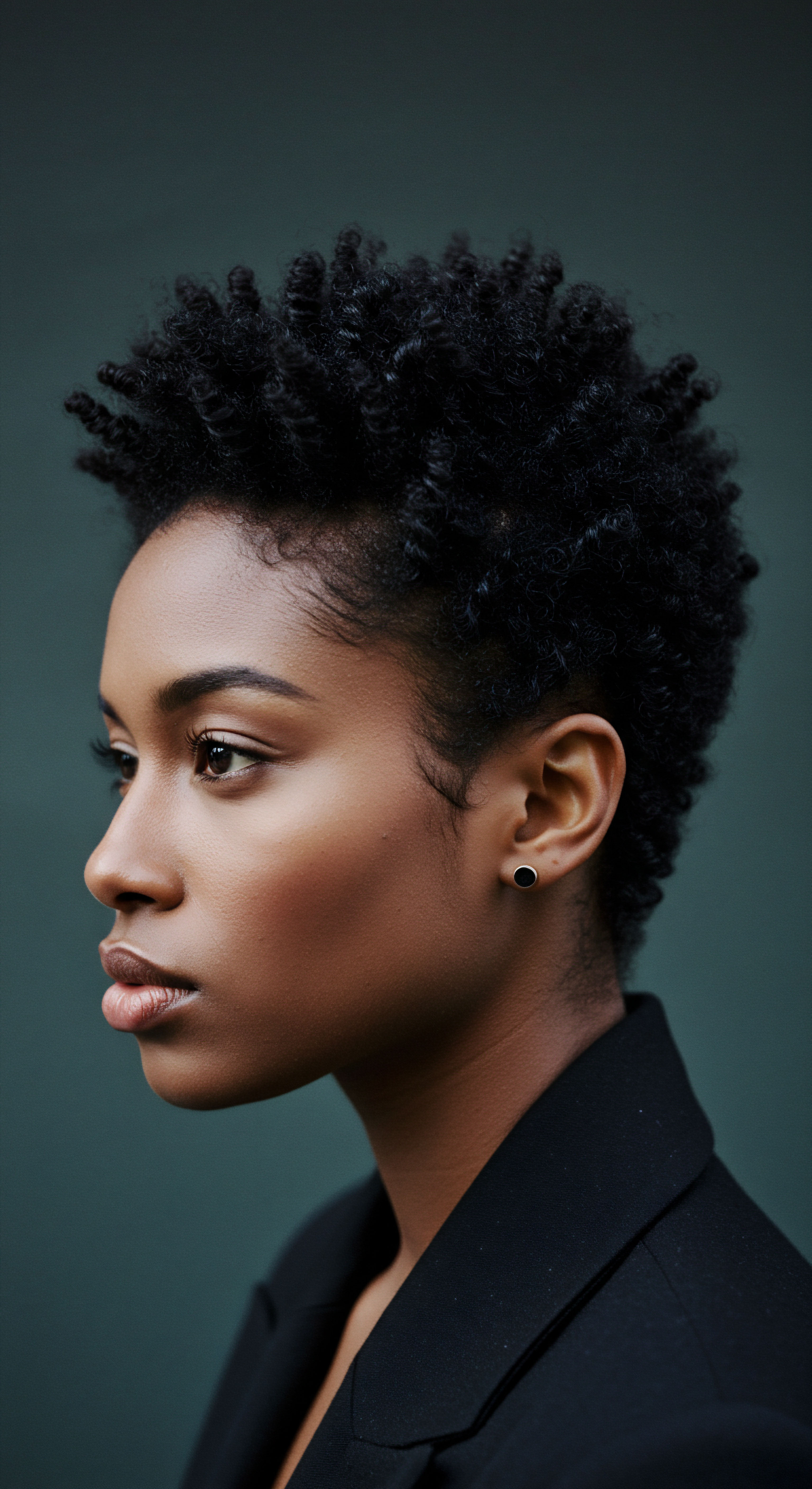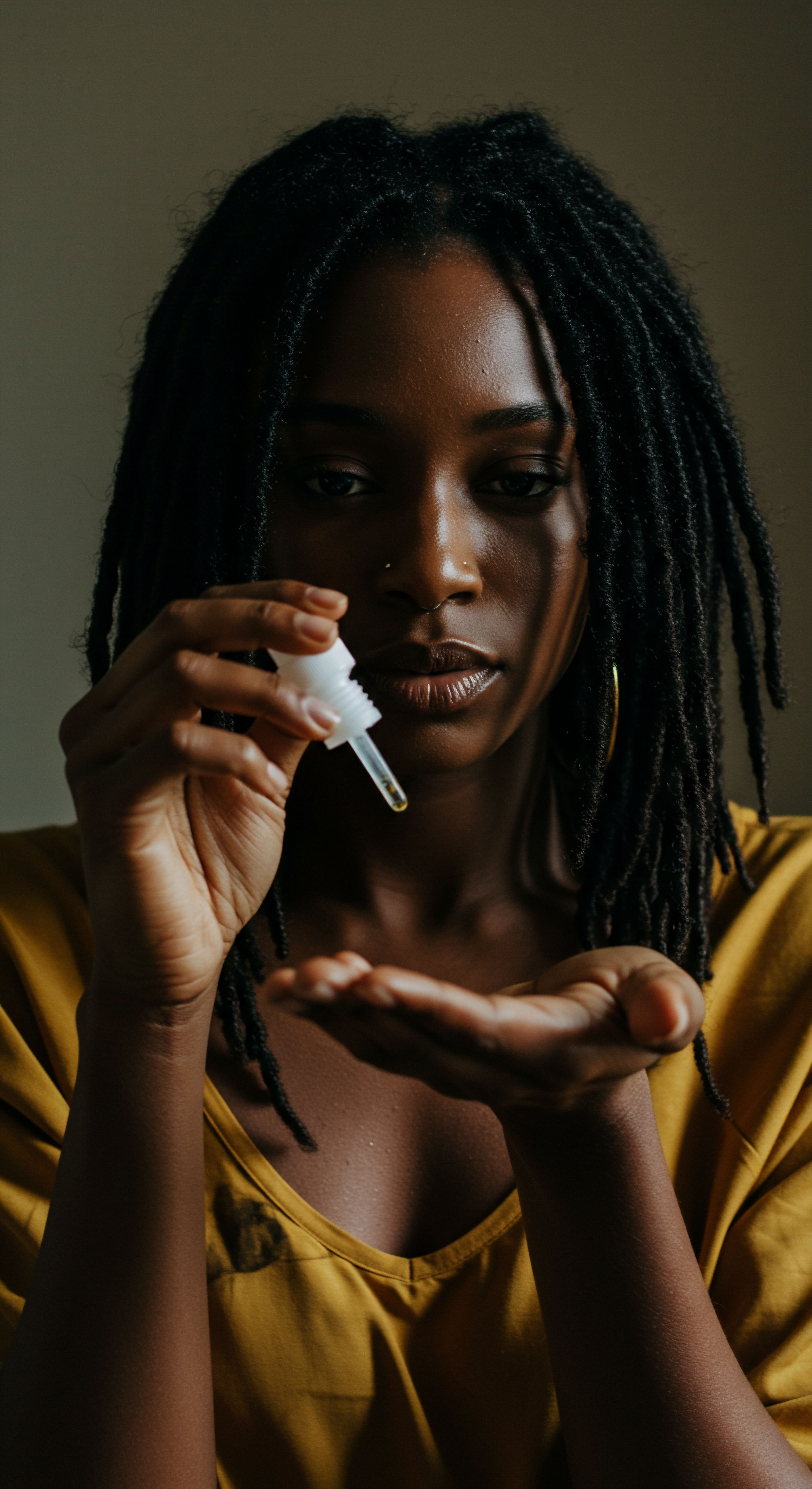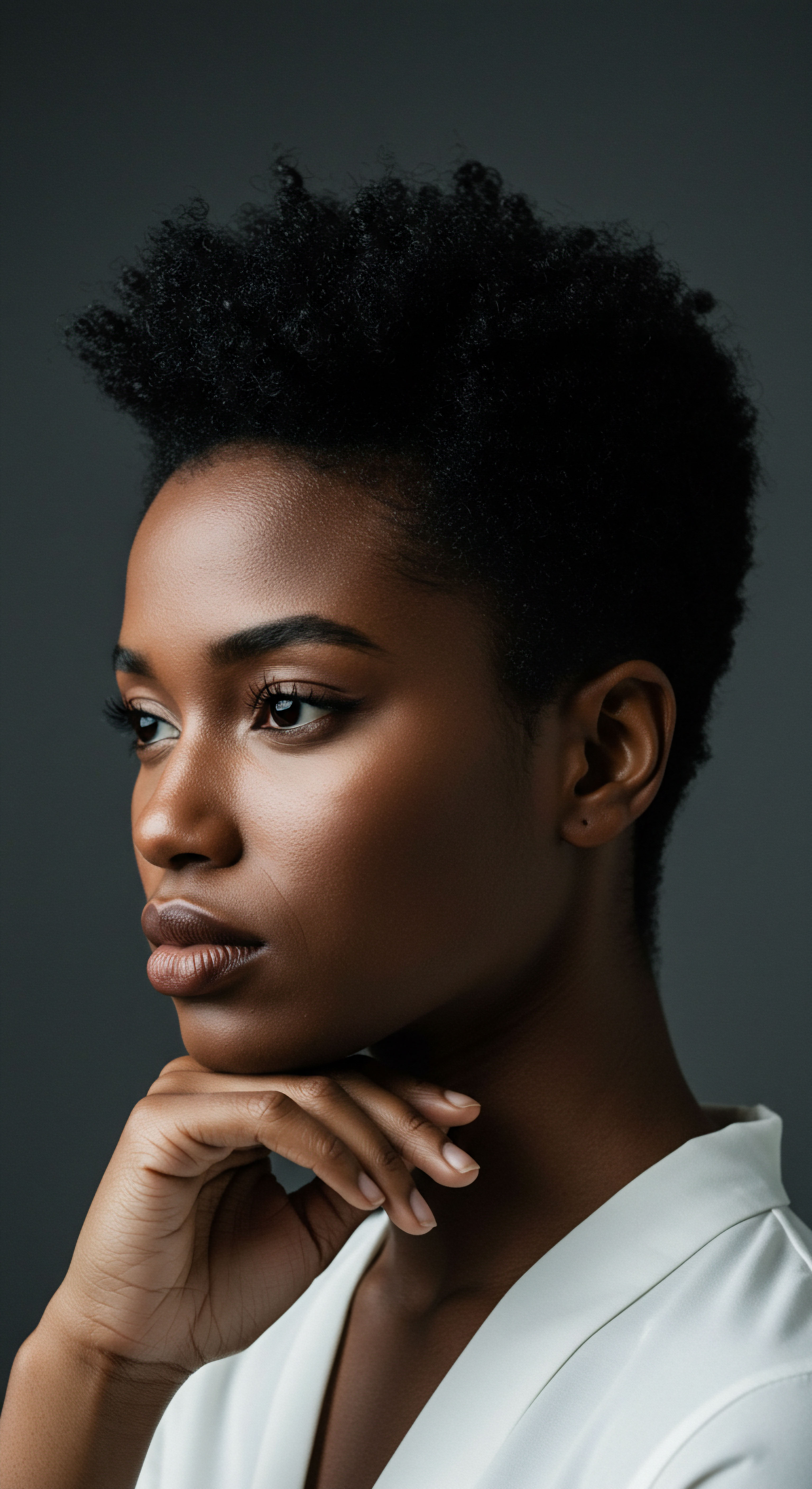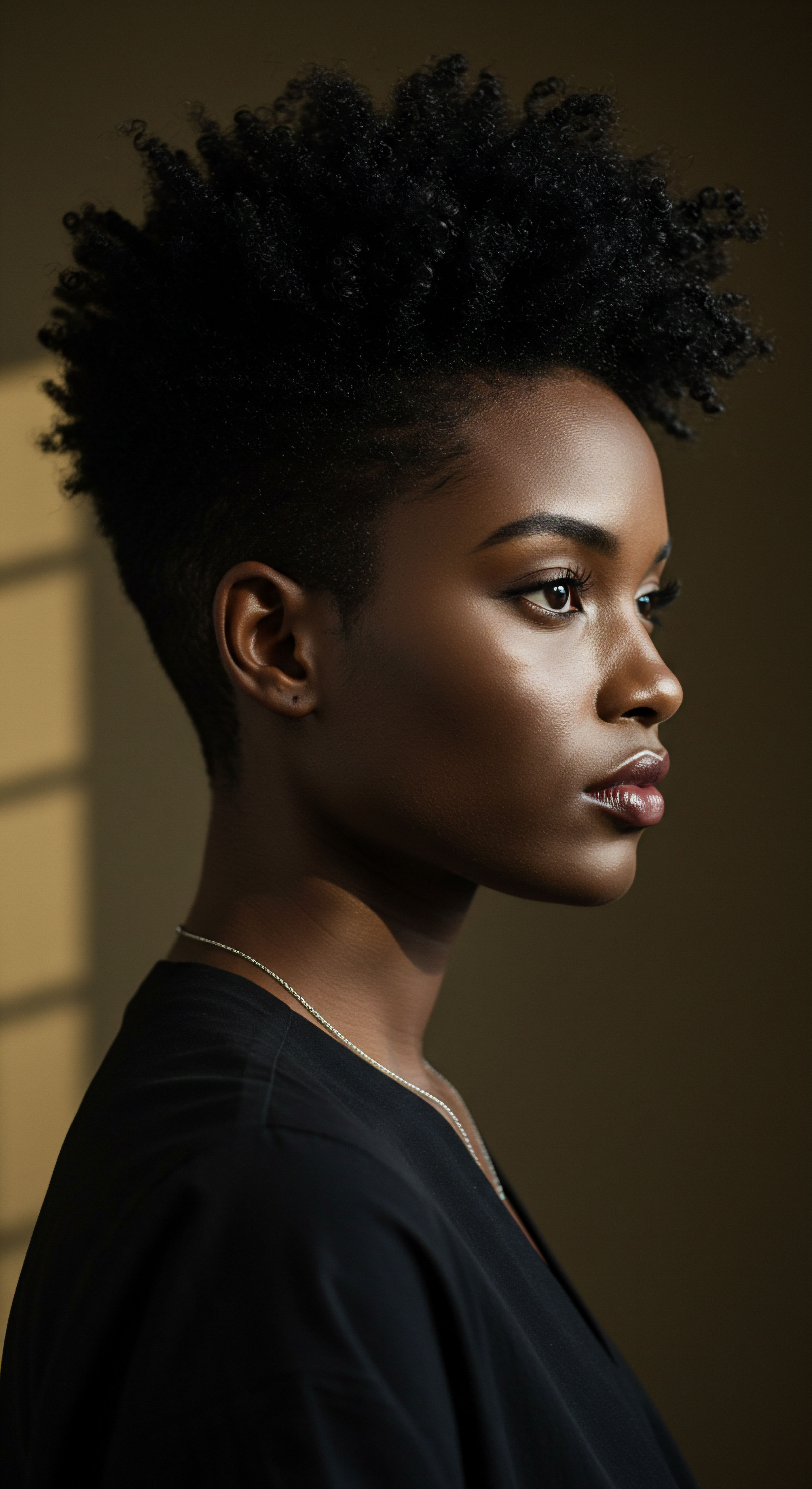
Roots
A quiet inquiry often surfaces when we consider the vitality of our coiled strands ❉ how does the hush of night, the profound stillness of sleep, truly contribute to their flourishing? It is a question that reaches beyond the surface of daily care, inviting us to look at the very elemental foundations of hair health. Our hair, a living extension of our inner landscape, participates in the grand rhythm of our bodies, a rhythm deeply influenced by the hours we spend in slumber. To truly grasp the connection between rest and the robust appearance of our textured hair, we must first understand the intricate workings beneath the surface, the biological symphony that plays out while we are unaware.
The life of a hair strand begins not with a styling product, but within the follicle, a tiny, remarkable organ nestled beneath the skin. Each follicle acts as a miniature factory, cycling through phases of growth, transition, and rest. For those with coiled hair, these cycles are particularly sensitive to internal and external conditions.
The shape of the follicle itself, dictating the curl pattern, also influences how nutrients reach the growing hair and how well the strand is protected from external pressures. A holistic perspective on hair growth acknowledges that the vibrancy we see on the outside is a direct reflection of the diligent, often unseen, processes occurring within.

The Hair Follicle and Its Nighttime Duties
Beneath the scalp’s surface, the hair follicle is a hub of activity, even as we drift into unconsciousness. This tiny structure contains specialized cells that are responsible for hair production. During periods of deep rest, the body dedicates resources to repair and regeneration across all systems, including the scalp and its follicles. This restorative period is not merely passive; it is a time of active cellular renewal, where the building blocks for new hair are synthesized and existing strands are fortified.
Consider the cellular turnover that occurs during sleep. The body’s natural repair mechanisms accelerate, working to mend daily wear and tear. For hair follicles, this means an opportunity to replenish cellular energy stores, produce essential proteins, and prepare for the next phase of growth. Without this dedicated time for repair, the cellular machinery within the follicle can become sluggish, potentially leading to a diminished capacity for robust hair production.

What Are Hair Growth Cycles?
Hair growth unfolds in a cyclical manner, a sequence known as the hair growth cycle. This cycle possesses three primary stages.
- Anagen ❉ This is the active growth phase, where hair cells divide rapidly, causing the hair shaft to lengthen. For scalp hair, this phase can persist for several years.
- Catagen ❉ A transitional phase, brief in duration, where hair growth ceases, and the follicle shrinks.
- Telogen ❉ The resting phase, during which the hair strand remains in the follicle but no active growth occurs. Following this phase, the hair sheds, and a new anagen phase begins.
The length of these phases can vary greatly among individuals and is influenced by genetics, nutrition, overall health, and environmental factors. Sleep plays a significant, though often underestimated, role in regulating these cycles, particularly by supporting the anagen phase and mitigating premature entry into the telogen phase.
The health of our coiled strands begins with the unseen, intricate cellular work occurring within the hair follicle during our hours of slumber.

Influencing Factors Beyond the Follicle
Beyond the immediate workings of the follicle, several systemic factors profoundly affect hair growth, many of which are intimately connected to our sleep patterns. Hormonal balance, for instance, plays a critical role. Hormones such as melatonin, often associated with sleep regulation, also exhibit a presence in hair follicles, suggesting a direct biological link to hair cycle regulation. Cortisol, the stress hormone, can disrupt the hair growth cycle when consistently elevated due to insufficient rest.
Blood flow to the scalp is another vital component. During sleep, the body prioritizes various functions, and optimal circulation ensures that hair follicles receive a steady supply of oxygen and nutrients. A compromised circulatory system, potentially stemming from poor sleep habits, could restrict these vital deliveries, thereby hindering the follicle’s ability to produce healthy hair. Understanding these foundational elements allows us to approach the topic of sleep and hair growth with a deeper appreciation for the body’s holistic design.

Ritual
The quiet moments before we surrender to sleep hold a subtle power, a potential to either bolster or inadvertently compromise the wellbeing of our coiled strands. Moving beyond the foundational science, we arrive at the practical wisdom, the daily and nightly practices that shape the lived experience of textured hair. It is within these routines, these gentle rituals, that we find opportunities to safeguard our hair, encouraging its growth and maintaining its unique beauty. The transition from day to night for coiled hair is not merely about resting the body; it is a chance to reset, to protect, and to prepare the strands for the journey ahead.
The specific habits we cultivate before bedtime possess a remarkable capacity to influence the structural integrity and growth trajectory of our hair. For coiled textures, which are inherently more prone to dryness and mechanical damage due to their unique structure, these nightly customs are not just recommendations; they are cornerstones of a comprehensive care regimen. A thoughtful nighttime approach minimizes friction, retains moisture, and supports the delicate balance required for sustained hair health.

Protecting Strands From Friction
One of the most common aggressors against coiled hair during sleep is friction. The constant rubbing against absorbent pillowcases can lead to tangles, breakage, and the stripping of natural oils. This is where the choice of sleep surface or hair covering becomes paramount.
Traditional cotton pillowcases, while comfortable for the skin, are notorious for their abrasive effect on hair. Their fibers can catch and pull at delicate coils, leading to frizz and split ends.
The introduction of smooth, low-friction materials into the sleep ritual offers a profound shield.
- Silk Pillowcases ❉ These provide a slick surface that allows hair to glide effortlessly, significantly reducing friction and preventing the disruption of the curl pattern.
- Satin Bonnets or Scarves ❉ Wrapping the hair in a satin bonnet or scarf before sleep creates a protective barrier, enclosing the strands and minimizing direct contact with the pillow. This also helps to maintain the integrity of styled hair, reducing the need for excessive manipulation the following day.
This simple shift in material can yield significant benefits, preserving moisture and preventing the mechanical stress that can impede healthy hair growth.

Maintaining Moisture Balance Overnight
Coiled hair naturally possesses an open cuticle layer, which allows moisture to escape more readily than straighter textures. The hours of sleep, particularly in dry environments, can exacerbate this moisture loss. A proactive approach to moisture retention overnight is therefore vital.
Consider a gentle application of a leave-in conditioner or a light hair oil before bed. This provides an additional layer of hydration, sealing the cuticle and preventing excessive moisture evaporation. The goal is not to saturate the hair but to provide just enough emollients to keep the strands supple and pliable throughout the night. This thoughtful pre-sleep conditioning helps maintain the hair’s elasticity, making it less susceptible to breakage from movement during sleep.
Nightly customs for coiled strands, such as using smooth sleep surfaces and gentle pre-sleep conditioning, safeguard against friction and moisture loss.

The Art of Hair Styling for Sleep
How hair is arranged before sleep also significantly influences its condition upon waking. Loose, unprotected hair is more prone to tangling and matting.
Certain protective styles are particularly beneficial for coiled hair overnight:
- Pineappling ❉ This involves gathering the hair into a loose, high ponytail or bun at the crown of the head, allowing the curls to spill forward. This keeps the bulk of the hair elevated and off the pillow, preserving curl definition and reducing flattening.
- Braids or Twists ❉ Creating two or more loose braids or twists before bed can protect the hair shaft from friction and stretching. This method is particularly effective for stretching curls or preparing them for specific next-day styles.
- Loose Buns or Knots ❉ For shorter or looser coils, a very loose bun secured with a soft scrunchie can offer protection without causing tension on the scalp.
The key with any of these styles is to ensure they are loose enough to prevent tension on the scalp, which can impede blood flow to the follicles, and tight enough to secure the hair without causing strain. The goal is to create a serene environment for the hair, allowing it to rest undisturbed and prepare for another day of vibrancy.
| Habit Low-Friction Surface |
| Benefit for Coiled Strands Minimizes breakage, reduces frizz, preserves moisture. |
| Practical Implementation Utilize silk or satin pillowcases; wear a satin bonnet or scarf. |
| Habit Moisture Retention |
| Benefit for Coiled Strands Prevents dryness, maintains elasticity, supports strand integrity. |
| Practical Implementation Apply a light leave-in conditioner or oil to ends before sleep. |
| Habit Protective Styling |
| Benefit for Coiled Strands Reduces tangles, maintains curl pattern, prevents stretching. |
| Practical Implementation Pineapple, loose braids, twists, or buns. |
| Habit Consistent Sleep Schedule |
| Benefit for Coiled Strands Regulates hormones, supports cellular repair, optimizes growth cycles. |
| Practical Implementation Establish a regular bedtime and wake-up time, even on weekends. |
| Habit These habits collectively safeguard coiled hair, promoting health and vitality. |

Relay
To truly comprehend the deep interplay between our nightly repose and the growth of coiled strands, we must look beyond surface-level care and delve into the intricate biological mechanisms and broader systemic influences. What less apparent complexities do the hours of sleep unearth regarding our hair’s vitality? This exploration requires a convergence of biological science, cultural insights, and a keen eye for the subtle signals our bodies transmit. It is within this profound insight that we uncover how sleep acts not merely as a pause, but as an active, orchestrating force for hair health, particularly for textures that demand a higher degree of physiological support.
The conversation around sleep and hair often focuses on the immediate, visible benefits of protection. Yet, the most significant contributions of quality sleep are happening at a cellular and hormonal level, far removed from the tangible touch of a satin bonnet. This deeper understanding reveals why prioritizing restorative sleep is not simply a lifestyle recommendation, but a fundamental pillar of any serious hair growth journey, especially for coiled hair, which relies heavily on optimal internal conditions for its structural integrity and resilience.

The Circadian Rhythm and Hair Cycle Synchronization
Our bodies operate on a sophisticated internal clock, the circadian rhythm, which governs nearly every physiological process, including the hair growth cycle. This rhythm dictates patterns of hormone secretion, cellular repair, and metabolic activity over a 24-hour period. Disruptions to this natural rhythm, often caused by inconsistent sleep schedules, shift work, or chronic sleep deprivation, can send confusing signals to the hair follicles.
Research indicates that hair follicles themselves possess their own circadian clocks, influencing the timing of cell division and gene expression related to hair production. When our systemic circadian rhythm is misaligned with these follicular clocks, the efficiency of hair growth can diminish. This misalignment can lead to a less synchronized anagen phase, potentially resulting in more hairs entering the resting or shedding phases prematurely. The body’s inability to fully engage in its natural repair processes during deep sleep means that the hair follicles may not receive the optimal conditions needed for sustained, vigorous growth.

Melatonin’s Role Beyond Sleep Regulation
Melatonin, widely known for its sleep-inducing properties, has garnered significant scientific interest for its potential direct influence on hair follicle biology. While the body naturally produces melatonin in response to darkness, its presence extends beyond the brain. Melatonin receptors have been identified within human hair follicles, suggesting a direct biological role in regulating the hair growth cycle.
A study published in the Journal of Pineal Research explored the effects of topical melatonin on hair growth. While primarily focused on diffuse alopecia, the findings presented a compelling, albeit less commonly discussed, dimension to melatonin’s capabilities. In a randomized, placebo-controlled study involving women with hair loss, topical melatonin application for six months led to a statistically significant increase in the percentage of hairs in the anagen (growth) phase and a decrease in the telogen (resting/shedding) phase compared to the placebo group.
This suggests that melatonin, beyond simply aiding sleep, may possess direct stimulatory effects on hair follicles, acting as a growth promoter. This points to the profound, interconnected nature of sleep-related biochemistry and its reach into seemingly disparate physiological systems like hair production.
Beyond visible protection, quality sleep orchestrates cellular and hormonal processes vital for coiled hair growth, highlighting its deep biological significance.

Hormonal Balance and Hair Health
Sleep acts as a crucial regulator of hormonal balance, a state that profoundly impacts hair health. Chronic sleep deprivation elevates cortisol levels, the body’s primary stress hormone. Persistently high cortisol can push hair follicles from the anagen (growth) phase into the telogen (resting) phase prematurely, leading to increased shedding, a condition often described as telogen effluvium.
Beyond cortisol, sleep influences the production of growth hormone, which peaks during deep sleep stages. Growth hormone plays a vital role in cellular regeneration and protein synthesis, both essential for robust hair production. Disruptions to sleep patterns can diminish growth hormone secretion, thereby limiting the body’s capacity to build and repair tissues, including those of the hair follicle. The delicate interplay of these hormones underscores the importance of consistent, quality sleep as a cornerstone for maintaining a thriving scalp environment conducive to growth.

Inflammation and Microcirculation
Sleep deprivation can also contribute to systemic inflammation, a state that can negatively affect the health of hair follicles. Chronic low-grade inflammation can impair microcirculation to the scalp, limiting the delivery of essential nutrients and oxygen to the growing hair. During restorative sleep, the body actively works to reduce inflammation and optimize blood flow, providing the follicles with the ideal conditions for cellular activity. This micro-level impact of sleep on scalp health often goes unnoticed but is critical for the long-term vitality of coiled strands.
The unique structure of coiled hair means that any compromise to its internal support system, whether through hormonal imbalance or impaired circulation, can have a more pronounced visible effect. The inherent dryness and structural fragility of coiled strands necessitate an even more diligent approach to holistic wellness, with sleep serving as a non-negotiable component of that wellness.

Reflection
As the quiet of night descends, and we settle into the promise of slumber, our coiled strands embark on their own silent, restorative work. The journey from the visible rituals of satin and protective styles to the unseen symphony of cellular repair and hormonal balance underscores a profound truth ❉ the vibrancy of our hair is inextricably linked to the depth of our rest. It is a reminder that genuine care extends beyond the superficial, inviting us to honor the body’s innate wisdom and its capacity for renewal. The beauty of our textured hair, in all its unique glory, stands as a testament to the quiet power of a well-rested existence, inviting us to listen more closely to the whispers of our own biological rhythms.

References
- Fischer, T. W. Burmeister, G. Schmidt, N. & Elsner, P. (2007). Melatonin increases anagen hair rate in women with androgenetic alopecia or diffuse alopecia ❉ results of a pilot randomized controlled trial. Journal of Pineal Research, 42(3), 374-379.
- Paus, R. & Cotsarelis, G. (2008). The biology of hair follicles. The New England Journal of Medicine, 359(12), 1269-1277.
- Slominski, A. T. Witali, J. & Zmijewski, M. A. (2018). The skin as a site of melatonin production and action. International Journal of Molecular Sciences, 19(6), 1680.
- Kwon, O. S. et al. (2012). The effects of stress on hair growth. Journal of Dermatological Science, 66(2), 101-107.
- Randall, V. A. (2008). Hormonal regulation of hair growth. Hair and Scalp Diseases, 2nd ed. 31-48.
- Trueb, R. M. (2015). Oxidative stress in ageing of hair. International Journal of Trichology, 7(1), 6-15.